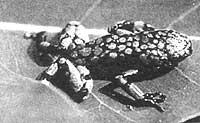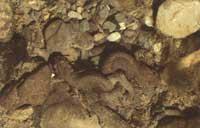Those dirty toads!
1988/06/01 Aihartza, Joxerra Iturria: Elhuyar aldizkaria
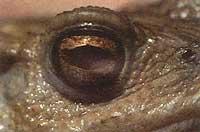
(...) "What will I say to you in favor of toad, which is the same destructive being, just name it to create the crudest disgust! The most damned of the cursed is rejection. For us it is a living trivial, a beast that represents all the horrors. What has this unfortunate done to become the center of universal condemnation?
Ugly! The soft body is a muddy mass blindfolded; the dorsal part, stepped and of dirty color, appears with pale clusters. Ugly! The legs, too short, are not able to lift the swollen belly from the mugs, and this, clumsily, drags. Ugly! In the broad head, instead of the mouth, it presents a slippery cleft, under the large eyelids, with a huge sharp and shocking eyes. It's ugly! It is inflated to any danger, under the skin of elastic leather and chain, forming a layer of air that protects it from all cracks.
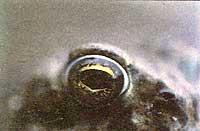
And poisonous! At the bottom of a dark hole, curled in the barros, it absorbs muddy humors, in the dorsal caves, to produce a milky edena that flows in moments of danger and wet the body. Poisonous! It throws into the eyes of the aggressors a liquid fuel –the urine– that with its viveza burns the light of the eyes. With the mold of the breath also contaminates the air. It is poisonous! The lip baba contaminates the herbs and fruits of the place. His footprints are as disgusting as harmful.
Ugly and poisonous!
If it is a merciless war, to the beast that also frees earth, air, water and gaze!
This is what the toad reproaches say."(...)
Start with J.H. French entomologist and naturalist FABRE, chapter dedicated to animals that about a hundred years ago are considered malefactors by man but considered beneficial. And XX. Although we are about to end the twentieth century, the main ideas presented to us in this text are still alive today.
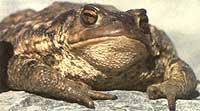
The common toad ( Bufo bufo ) is the most famous amphibian in the Basque Country and, for most of them, the most ugly. Although it usually has a length of 10-12 cm, it can reach the 15 cm, being the most difficult of our mountains and fields.
The activity of the toad begins at dusk and carries a nightlife. It is a quiet walker and able to give jumps, but for his short legs and his robust body does not get at all the slenderness of the frogs. This, in addition, would be related to his more nocturnal and dry life. And it is that making big jumps at night is not such an adequate means of defense, without knowing where it will fall. And thanks to this and the terrestrial color, it becomes invisible for both predators and invertebrates that will be their prey.
Although they are usually solitary animals, in spring they are concentrated in ponds and streams for reproduction, as do most other amphibians. At this time the fights between males are numerous. The coupling –or extension– can be extended for several days, during which the female lays thousands of eggs in laces of a few meters of length. After the fertilization of the last eggs, the couple separates to remake their solitary life.
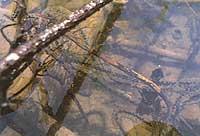
Compared to adult animals, the nipples of the toads are usually small, with a maximum of 4-5 cm. They are dark, almost black, and their development time appears associated with the water temperature. The most evident identifying signs of these capitals are the central obverse, the rounded tail and the esplanade of the spiral to the left. The duration of the metamorphosis is usually about a month, with a peak landing of 10 mm in length.
These sapitos, in late spring or early summer, offer a truly fun show when they leave the wells to a hundred and begin to give the first clumsy jumps towards the ground of lamb. Who then says that with some increase they will have a poor reception among human beings?
And the truth is that the reason for that intense hatred toward the apoos is only found in two ideas: the ugly appearance and the fear that generates poison.
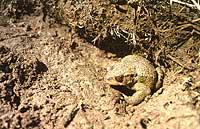
And what to say about the image? Anyone who has looked with some attention to toad knows that it is difficult to find among the rest of the animals of our village as curious as their fire colored eyes. As for the general aspect, however, the beauty of the toad, or the lack of beauty (? )- is simply the part of his life. Granular skin and terrestrial color are obligatory, both to hunt and to hide from other hunters. Therefore, and despite the comments, the beauty of the toad is nothing more than what suits it.
As for poison, the milky poison that produces the toad in the dorsal part of the neck (in special structures called parotoid glands) is a mere defensive.
In the liquid secreted by these special glands appear toxic substances known as bufotoxins, but these substances, to be effective, have to reach the blood and the toad lacks mechanisms –neither teeth, neither thorns, nor other rigid structures–. However, this poison has become the best defense of the toad. In fact, if an enemy attacks the toad, the parotoid glands secrete milk, which burns the mouth and digestive tract of the predator, causing vomiting in the aggressor. Is the disgust and fear we have now not the hidden memory of some bad experience that comes to us from prehistory?
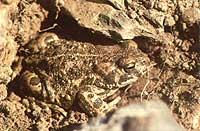
The toad has no danger to the human being and all those related to venomous saliva, contagious baba and exciting fins are a mere mythology. At most, if you take the toad in your hands and get wet of milk and/or urine, it is recommended to wash your hands to avoid irritations in the eyes or hands.
But the toad is not only harmless, but beneficial.
Being a great callus, he eats on a daily basis countless calluses, beetles and other invertebrates in his walks through gardens and fields of cultivation. According to Lescure (1965), three-quarters of the coleoptera that eats toads are considered harmful. The help of this hungry animal has long been known in England. In the last century they were sold and bought on the market and took home with care to live in gardens and greenhouses, eating their bugs and taking care of the plants. And in Euskal Herria, if you find a vegetable garden, you get into a stick and leave the indecent sun to be dry and rough little by little. Great prize for man!
Besides the common toad ( Bufo bufo ), in the south of Euskal Herria also lives the toad corridor ( B. calamita ). Although smaller than the previous one, everything said in general serves the sapo corridor, both in terms of the way of life and biology, as well as the mythology created in its environment.
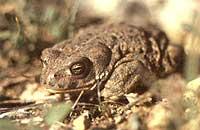
His name comes from his itinerant custom; to escape his enemies and to hunt, he prefers to run without just jumping. The toad runner is inductor and for it uses front and back legs, opening great paths in sand or spongy land. It consists mainly of ants that can be found in food, land and sand.
From the point of view of the geographical distribution, the common toad ( B. bufo ) is much more widespread than the corridor toad ( B. calamita ) and is found practically throughout the Basque Country, although in the Cantabrian cornice it is more abundant than in the southern ones. On the contrary, the sapo corridor ( B. calamita ) is only located in the southern zone, with the only exception of some small coastal colonies. While the colonies that inhabit the Mediterranean region are strong, these small coastal colonies are about to be lost. In fact, most of the breeding wells have been dried.

Gai honi buruzko eduki gehiago
Elhuyarrek garatutako teknologia




